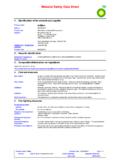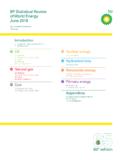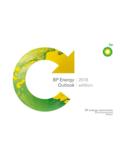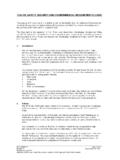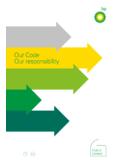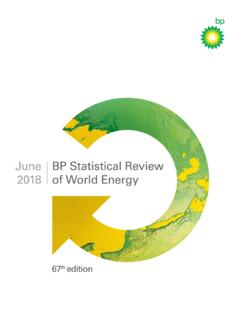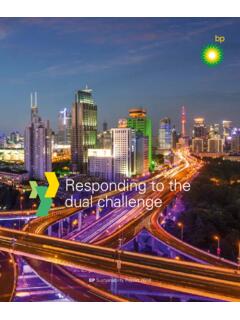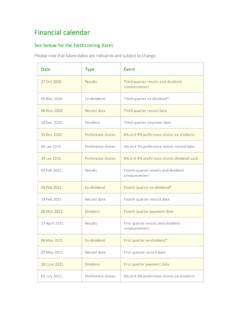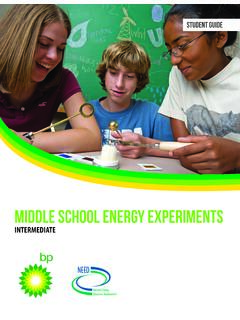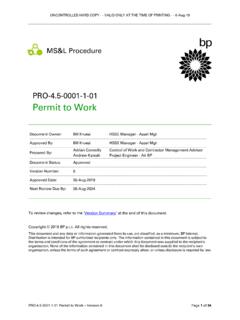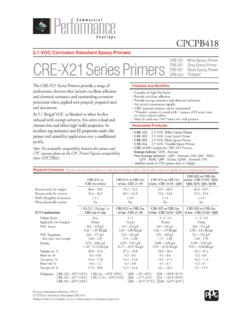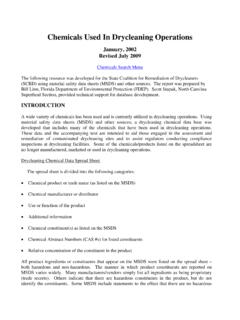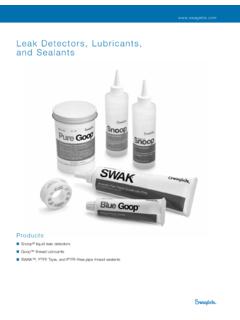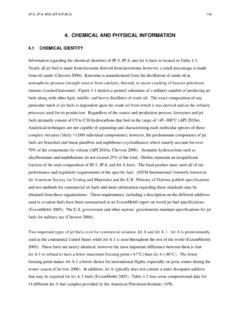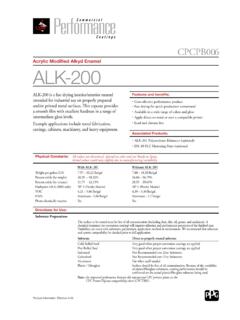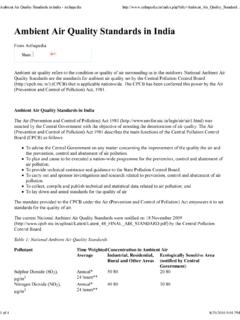Transcription of Material Safety Data Sheet - BP
1 Material Safety data Sheet1 .Identification of the Material and supplierBP Premium Unleaded PetrolProduct name876 Historic SDS useFuel for spark ignition engines. NOT for aviation specific application advice see appropriate Technical data Sheet or consult our Australia Pty Ltd (ABN 53 004 085 616)717 Bourke StreetDocklands VIC 3008 AustraliaTel: +61 (03) 9268 4111 Fax: +61 (03) 9268 3321 Supplier1800 638 556 EMERGENCY TELEPHONENUMBERP roduct code0000002734 Hazards identification2 .HAZARDOUS SUBSTANCE. DANGEROUS ofhazardous/dangerous natureR12- Extremely May cause May cause heritable genetic Possible risk of harm to the unborn Also harmful: may cause lung damage if Irritating to Vapours may cause drowsiness and Toxic to aquatic organisms, may cause long-term adverse effects in the aquatic phrasesS2- Keep out of the reach of Keep away from sources of ignition - No Do not breathe gas/fumes/ Avoid contact with Do not empty into Wear suitable protective clothing and In case of accident or if you feel unwell, seek medical advice immediately (show the label wherepossible).
2 S61- Avoid release to the environment. Refer to special instructions/ Safety data If swallowed, do not induce vomiting: seek medical advice immediately and show this containeror phrasesComposition/information on ingredients3 .Petrol86290-81-5>90 Contains:Benzene71-43-2<1tert-butyl alcohol75-65-0<1tert-butyl methyl ether1634-04-4<1 Polycyclic aromatic hydrocarbons (PAHs)mixture<1diisopropyl ether108-20-3<1 Ingredient nameCAS contactIn case of contact, immediately flush eyes with plenty of water for at least 15 minutes. Eyelids shouldbe held away from the eyeball to ensure thorough rinsing. Check for and remove any contact medical attention if irritation case of contact, immediately flush skin with plenty of water for at least 15 minutes while removingcontaminated clothing and shoes. Drench contaminated clothing with water before removing. This isnecessary to avoid the risk of sparks from static electricity that could ignite contaminated clothing is a fire hazard.
3 Contaminated leather, particularly footwear, must bediscarded. Wash clothing before reuse. Clean shoes thoroughly before reuse. Get medical .Eye contactFirst-aid measuresDate of issue26 April 2012 Page: 1/6BP Premium Unleaded PetrolProduct nameProduct codeVersion3 FormatLanguageAustralia0000002734 ENGLISH(ENGLISH)(Australia)Get medical attention immediately. If inhaled, remove to fresh air. If not breathing, if breathing isirregular or if respiratory arrest occurs, provide artificial respiration or oxygen by trained personnel. If exposure to vapour, mists or fumes causes drowsiness, headache, blurred vision or irritation of theeyes, nose or throat, remove immediately to fresh air. Keep patient warm and at rest. If any symptomspersist obtain medical medical attention immediately. Do not induce vomiting. Never give anything by mouth to anunconscious person. If unconscious, place in recovery position and get medical attention hazard if swallowed.
4 Can enter lungs and cause measures5 .Fire water contaminated with this Material must be contained and prevented from being discharged toany waterway, sewer or drain. Move containers from fire area if this can be done without risk. Noaction shall be taken involving any personal risk or without suitable training. Promptly isolate thescene by removing all persons from the vicinity of the incident if there is a fire. This Material is toxic toaquatic organisms. Use water spray to keep fire-exposed containers fire-fightingproceduresFire-fighters should wear appropriate protective equipment and self-contained breathing apparatus(SCBA) with a full face-piece operated in positive pressure of fire-fightersUnusual fire/explosionhazardsExtremely flammable liquid. In a fire or if heated, a pressure increase will occur and the container mayburst, with the risk of a subsequent explosion. Runoff to sewer may create fire or explosion code3 YEHazardous decompositionproductsDecomposition products may include the following materials: carbon oxides (CO, CO2) (carbonmonoxide, carbon dioxide)Extinguishing mediaSuitableIn case of fire, use water fog, foam, dry chemical or carbon dioxide extinguisher or not use water suitable6.
5 Accidental release measuresEnvironmental precautionsPersonal precautionsStop leak if without risk. Move containers from spill area. Approach the release from upwind. Prevententry into sewers, water courses, basements or confined areas. Wash spillages into an effluenttreatment plant or proceed as follows. Contain and collect spillage with non-combustible, absorbentmaterial sand, earth, vermiculite or diatomaceous earth and place in container for disposalaccording to local regulations. Use spark-proof tools and explosion-proof equipment. Dispose of via alicensed waste disposal contractor. Contaminated absorbent Material may pose the same hazard asthe spilt action shall be taken involving any personal risk or without suitable training. Evacuate surroundingareas. Keep unnecessary and unprotected personnel from entering. Do not touch or walk throughspilt Material . Shut off all ignition sources.
6 No flares, smoking or flames in hazard area. Avoidbreathing vapour or mist. Provide adequate ventilation. Wear appropriate respirator when ventilationis inadequate. Put on appropriate personal protective equipment (see Section 8).Avoid dispersal of spilt Material and runoff and contact with soil, waterways, drains and the relevant authorities if the product has caused environmental pollution (sewers, waterways,soil or air). Water polluting Material . May be harmful to the environment if released in spillStop leak if without risk. Move containers from spill area. Dilute with water and mop up if water-soluble. Alternatively, or if water-insoluble, absorb with an inert dry Material and place in anappropriate waste disposal container. Use spark-proof tools and explosion-proof equipment. Disposeof via a licensed waste disposal spillHandlingHandling and storageStorage7 .Put on appropriate personal protective equipment.
7 Avoid exposure - obtain special instructions beforeuse. Avoid exposure during pregnancy. Do not get in eyes or on skin or clothing. Do not hazard Can enter lungs and cause damage. Never siphon by mouth. Avoid breathingvapour or mist. Avoid contact of spilt Material and runoff with soil and surface waterways. Use onlywith adequate ventilation. Wear appropriate respirator when ventilation is inadequate. Keep in theoriginal container or an approved alternative made from a compatible Material , kept tightly closedwhen not in use. Store and use away from heat, sparks, open flame or any other ignition source. Useexplosion-proof electrical (ventilating, lighting and Material handling) equipment. Use non-sparkingtools. Take precautionary measures against electrostatic discharges. Do not reuse container. Emptycontainers retain product residue and can be in a segregated and approved area.
8 Keep container in a cool, well-ventilated area. Keepcontainer tightly closed and sealed until ready for use. Avoid all possible sources of ignition (spark orflame). Store and use only in equipment/containers designed for use with this product. Do not removewarning labels from not enter storage tanks without breathing apparatus unless the tank has been well ventilated andthe tank atmosphere has been shown to contain hydrocarbon vapour concentrations of less than1% of the lower flammability limit and an oxygen concentration of at least 20% hydrocarbon vapours can build up in the headspace of tanks. These can causeflammability/explosion hazards even at temperatures below the normal flash point (note: flash pointmust not be regarded as a reliable indicator of the potential flammability of vapour in tankheadspaces). Tank headspaces should always be regarded as potentially flammable and care shouldbe taken to avoid static electrical discharge and all ignition sources during filling, ullaging andsampling from storage of issue26 April 2012 Page: 2/6BP Premium Unleaded PetrolProduct nameProduct codeVersion3 FormatLanguageAustralia0000002734 ENGLISH(ENGLISH)(Australia)When the product is pumped ( during filling, discharge or ullaging) and when sampling, there is arisk of static discharge.
9 Ensure equipment used is properly earthed or bonded to the tank product comes into contact with hot surfaces, or leaks occur from pressurised fuel pipes, the vapouror mists generated will create a flammability or explosion contaminated rags, paper or Material used to absorb spillages, represent a fire hazard, andshould not be allowed to accumulate. Dispose of safely immediately after product must be handled in compliance with Australian Standard: The storage and handling offlammable and combustible liquids [Standard 1940-2004 as amended and adapted].Additional information-Storage8 .Exposure controls/personal protectionIngredient nameOccupational exposure limitsGasolineACGIH TLV (United States, 5/2004).STEL: 1480 mg/m315 minute(s). Form: All forms STEL: 500 ppm 15 minute(s). Form: All forms TWA: 890 mg/m38 hour(s). Form: All forms TWA: 300 ppm 8 hour(s). Form: All formsBenzeneNOHSC (Australia, 8/2005).
10 TWA: mg/m38 hour(s). TWA: 1 ppm 8 hour(s).tert-butyl methyl etherNOHSC (Australia, 8/2005).STEL: 275 mg/m315 minute(s). STEL: 75 ppm 15 minute(s). TWA: 92 mg/m38 hour(s). TWA: 25 ppm 8 hour(s).2-Methylpropan-2-olNOHSC (Australia, 1995).STEL: 455 mg/m315 minute(s). STEL: 150 ppm 15 minute(s). TWA: 303 mg/m38 hour(s). TWA: 100 ppm 8 hour(s).Polycyclic aromatic hydrocarbons (PAHs)NOHSC (Australia).TWA: mg/m38 hour(s).diisopropyl etherNOHSC (Australia, 8/2005).STEL: 1300 mg/m315 minute(s). STEL: 310 ppm 15 minute(s). TWA: 1040 mg/m38 hour(s). TWA: 250 ppm 8 hour(s).For information and guidance, the ACGIH values are included. For further information on these please consult your exhaust ventilation or other engineering controls to keep the airborne concentrations ofvapours below their respective occupational exposure that eyewash station and Safety shower is proximal to the workstation location.
